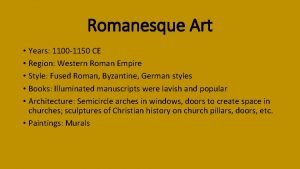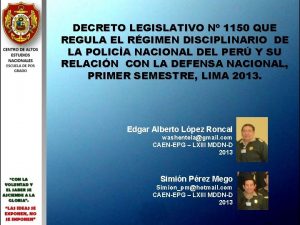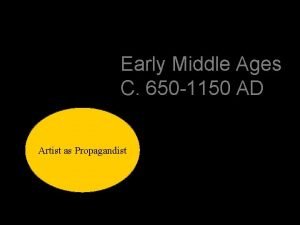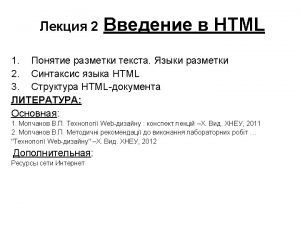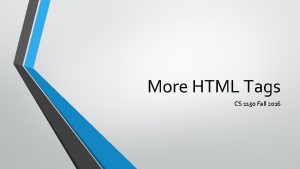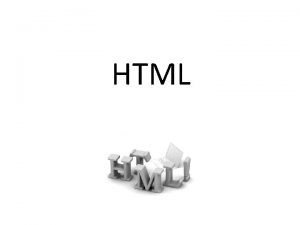HTML Links CS 1150 Fall 2016 HTML Links













- Slides: 13

HTML Links CS 1150 Fall 2016

HTML Links • Links are the defining feature of the internet because they allow you to move from one webpage to another – enabling the very idea of surfing • You will commonly come across the following types of links: • • Links from one website to another Links from one page to another on the same website Links from one part of a webpage to another part of the same page Links that open in a new browser window

Creating a Link in HTML • Links are created using the <a> element • Users can click on anything between the opening <a> tag and the closing </a> tag • You specify which page you want to link to using the href attribute

• The text between the opening <a> tag and closing </a> tag is known as link text • Where possible, your link text should explain where visitors will be taken if they click on it (rather than just saying “click here”) • Below is an example link in HTML with link text IMDB and a URL of http: //www. imdb. com. <a href=“http: //www. imdb. com”>IMDB</a> ---------------opening link tag----------------- closing tag

Linking to Other Sites • • When you link to a different website, the value of the href attribute will be the full web address for the site, which is known as the absolute URL The absolute URL is the web address you would type into a browser if you wanted to visit that specific page An absolute URL starts with the domain name for that site, and can be followed by the path to a specific page. If no page is specified, the site will display the homepage Example file: https: //www. cs. mtsu. edu/~crn 2 k/public/courses/1150/linking_to_other_sites. html

Linking to Other Pages on the Same Site • When you are linking to other pages within the same site, you do not need to specify the domain name in the URL. You can use shorthand known as a relative URL • If all the pages of the site are in the same folder, then the value of the href attribute is just the name of the file • If you have different pages of a site in different folders, then you can use a slightly more complex syntax to indicate where the page is in relation to the current page • Example file: https: //www. cs. mtsu. edu/~crn 2 k/public/courses/1150/linking_to_the_same_site. html

Directory Structure • The directory structure is the structure of folders on the webserver where a website is hosted • The top-level folder is known as the root folder (public_html is our root folder) • The main homepage of a site is placed in the root folder and is called index. html • Webservers are set up to return the index. html file if no other filename is specified

More on Directory Structure • Every page and every image on a website has a URL (Uniform Resource Locator). The URL is made up of the domain name followed by the path to that page or image. • You can use URLs when linking to other pages or images in your own site

Relative URLs • When are you are linking to a page on your own website, you do not need to specify the domain name • You can use relative URLs, which are a shorthand way to tell the browser where a page is in relation to the current page • If all the files on your site are in one folder, you simply use the file name for that page

Using Relative URLs Relative Link Type Example Same folder <a href=“reviews. html”>Reviews</a> Child folder <a href=“music/listings. html”>Listings</a> Grandchild folder <a href=“movies/dvd/reviews. html”>Reviews</a> Parent folder <a href=“. . /index. html”>Home</a> Grandparent folder <a href=“. . /index. html”>Home</a>

Opening Links in a New Window • • If you want a link to open in a new window, you can use the target attribute on the opening <a> tag The value of this attribute should be _blank Example: <a href=“http: //www. imdb. com” target=“_blank”>Internet Movie Database</a> Example file: https: //www. cs. mtsu. edu/~crn 2 k/public/courses/1150/opening_links_in_new_wind ow. html

Linking to a Specific Part of the Same Page • At the top of a long page, you might want to add a list of contents that links to the corresponding sections lower down • Or, you might want to add a link from part way down the page back to the top of it to save users from having to scroll back to the top • Example file: https: //www. cs. mtsu. edu/~crn 2 k/public/courses/1150/linking_to_the_same_ page. html

Linking to a Specific Part of Another Page • To add a link to a specific part of a different page, use the same techniques as linking to the same page • The href attribute will contain the address for the page, followed by the # symbol, followed by the value of the id attribute that is used on the element you are linking to • Example file: https: //www. cs. mtsu. edu/~crn 2 k/public/courses/1150/linking_to_part_of_an other_page. html


